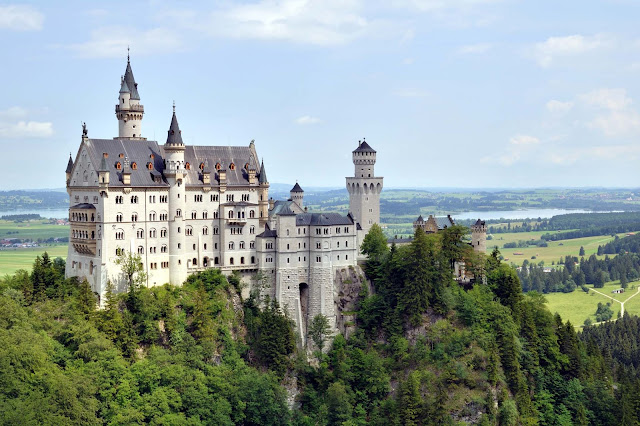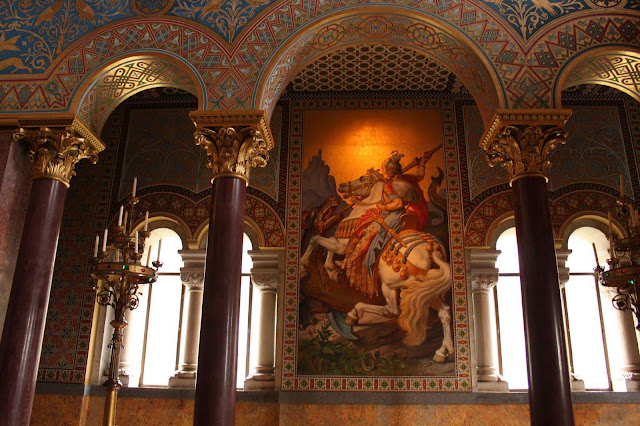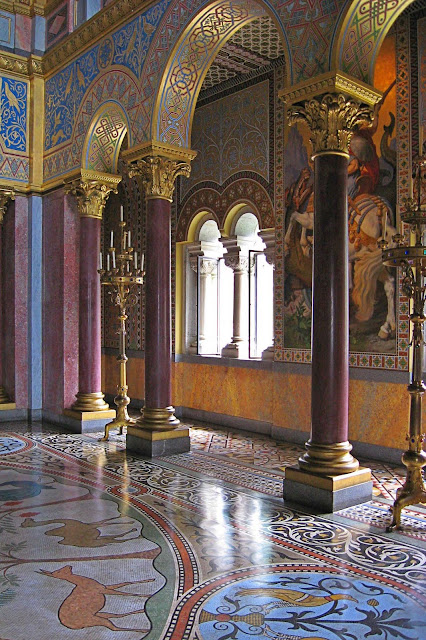Neuschwanstein Castle is a 19th-century Gothic Revival palace on a rugged hill above the village of Hohenschwangau near Füssen in southwest Bavaria, Germany. The palace was commissioned by Ludwig II of Bavaria as a retreat and as homage to Richard Wagner.
 |
| Neuschwanstein |
The palace was intended as a personal refuge for the reclusive king, but it was opened to the paying public immediately after his death in 1886. Since then over 60 million people have visited Neuschwanstein Castle. More than 1.3 million people visit annually, with up to 6,000 per day in the summer. The palace has appeared prominently in several movies and was the inspiration for Disneyland's Sleeping Beauty Castle[4] and later, similar structures.
The municipality of Schwangau lies at an elevation of 800 m (2,620 ft) at the south west border of the German state of Bavaria. Its surroundings are characterized by the transition between the Alpine foothills in the south (towards the nearby Austrian border) and a hilly landscape in the north that appears flat by comparison. In the middle Ages, three castles overlooked the village.
One was called Schwanstein Castle. In 1832, Ludwig's father King Maximilian II of Bavaria bought its ruins to replace them by the comfortable neo-Gothic palace known as Hohenschwangau Castle. Finished in 1837, the palace became his family's summer residence, and his elder son Ludwig (born 1845) spent a large part of his childhood here.
Vorderhohenschwangau Castle and Hinterhohenschwangau Castle sat on a rugged hill overlooking Schwanstein Castle, two nearby lakes, and the village. Separated only by a moat, they jointly consisted of a hall, a keep, and a fortified tower house. In the 19th century only ruins remained of the medieval twin castles, but those of Hinterhohenschwangau served as a lookout place known as Sylphenturm.
The ruins above the family palace were known to the crown prince from his excursions. He first sketched one of them in his diary in 1859. When the young king came to power in 1864, the construction of a new palace in place of the two ruined castles became the first in his series of palace building projects. Ludwig himself called the new palace New Hohenschwangau Castle - only after his death was it renamed Neuschwanstein. The confusing result is that Hohenschwangau and Schwanstein have effectively swapped names: Hohenschwangau Castle replaced the ruins of Schwanstein Castle, and Neuschwanstein Castle replaced the ruins of the two Hohenschwangau Castles.
Text source:- Wikipedia. Images are copyrighted by their owners. Found any copyright issue, contact the administrator immediately. Report it now!
You have read this article Castles /
Europe /
Germany
with the title Neuschwanstein. You can bookmark this page URL http://tiffanyeatworld.blogspot.com/2011/06/neuschwanstein.html. Thanks!









































